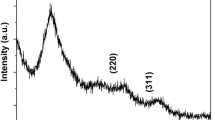Abstract
Thiol-capped PbS semiconductor nanoparticles (NPs) stabilized with a mixture of 1-thioglycerol/dithioglycerol (TGL/DTG) were colloidally prepared at room temperature. UV–vis spectroscopy and photoluminescence (PL) spectra showed an obvious red-shift in both the absorption shoulder and PL peak with the increase of DTG/Pb molar ratio. Room temperature photoluminescence quantum efficiency (PLQE) of freshly prepared PbS NPs (7–11%) remained higher than 5% upon aging for 3 weeks when the NPs were stored in an ice-bath in the dark, and higher than 5% for at least 5 weeks when additional DTG ligand was introduced into the nanoparticle solution every 2 weeks. The combination of reasonable room temperature quantum efficiency and strong, stable luminescence covering the 1.3 μm telecommunication window make these NPs promising materials in optical devices and telecommunications.





Similar content being viewed by others
Notes
We note that some 1–8% uncertainty in the measurement of quantum efficiency may apply to the nanocrystals in this figure. It was omitted for clarity.
Additional 0.33 mmol of DTG were introduced into the nanocrystal solution and stirred for 5 min every 2 weeks.
References
Murray CB, Norris DJ, Bawendi MG (1993) J Am Chem Soc 115:8706
Alivisatos AP (1996) Science 271:933
Li JJ, Wang YA, Guo W, Keay JC, Mishima TD, Johnson MB, Peng X (2003) J Am Chem Soc 125:12567
Bruchez M, Moronne M, Gin P, Weiss S, Alivisatos AP (1998) Science 281:2013
Chan WCW, Nie SM (1998) Science 281:2016
Peng AZ, Peng X J Am Chem Soc (2001) 123:183
Gaponik N, Talapin DV, Rogach AL, Hoppe K, Shevchenko EV, Kornowski A, Eychmuller A, Weller H (2002) J Phys Chem B 106:7177
Aldana J, Wang YA, Peng X (2001) J Am Chem Soc 123:8844
Bakueva L, Musikhin S, Hines MA, Chang T-WF, Tzolov M, Scholes GD, Sargent EH (2003) Appl Phys Lett. 82:2895
Hines MA, Scholes GD (2003) Adv Mater 15:1844
Lee S-M, Jun Y-W, Cho S-N, Cheon J (2002) J Am Chem Soc 124:11244
Kane RS, Cohen RE, Silbey R (1996) Chem Mater 8:1919
Patel AA, Wu F, Zhang JZ, Torres-Martinez CL, Mehra RK, Yang Y, Risbud SH (2000) J Phys Chem B 104:11598
Wang S, Yang S (2000) Langmuir 16:389
Chen S, Truax LA, Sommers JM (2000) Chem Mater 12:3864
Zhou Y, Itoh H, Uemura T, Naka K, Chujo Y (2002) Langmuir 18:5287
Wundke K, Auxier J, Schülzgen A, Peyghambarian N, Borelli NF (1999) Appl Phys Lett 75:3060
Sukhovatkin V, Musikhin S, Gorelikov I, Cauchi S, Bakueva L, Kumacheva E, Sargent EH (2005) Optics Lett 13:344
Bakueva L, Gorelikov I, Musikhin S, Zhao XS, Sargent EH, Kumacheva E (2004) Adv Mater 16:926
Zhao XS, Gorelikov I, Musikhin S, Cauchi S, Sukhovatkin V, Sargent EH, Kumacheva E (2005) Langmuir 21:1086
Qu L, Peng X (2002) J Am Chem Soc 124:2049
Acknowledgements
Xusheng Zhao is grateful to the support of K.C. Wong Education Foundation, Hong Kong. This work was partly supported by National Natural Science Foundation of China, Scientific Research Foundation for the Returned Overseas Chinese Scholars, State Education Ministry, Guangdong Natural Science Foundation and Guangzhou municipal government. The authors thank Prof. Eugenia Kumacheva from the Department of Chemistry, University of Toronto, for fruitful discussions.
Author information
Authors and Affiliations
Corresponding author
Rights and permissions
About this article
Cite this article
Zhao, XS., Xu, SY., Liang, LY. et al. Luminescent stability of water-soluble PbS nanoparticles. J Mater Sci 42, 4265–4269 (2007). https://doi.org/10.1007/s10853-006-0679-2
Received:
Accepted:
Published:
Issue Date:
DOI: https://doi.org/10.1007/s10853-006-0679-2



